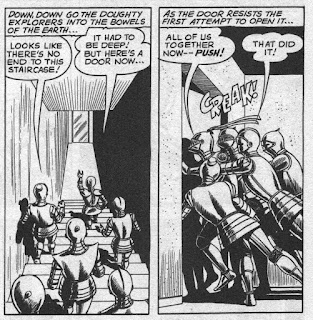1 / 5 Stars
This paperback edition (a revised version of the original 1953 novel) of ‘The Time Masters’ (160 pp) was published by Lancer Books in 1971; the cover artist is uncredited, but likely is Gene Szafran.
The novel is set in the early 70s, and takes place in Knoxville, Tennessee.
The opening chapters focus on the actions of a man named Gilbert Nash, who has captured the attention of a top-secret team of federal agents who are responsible for security and counterespionage at the Oak Ridge atomic research facility. Why their interest ? Because Nash has an uncanny history of placing himself in proximity to the most important dates and places in America’s atomic research program.
The feds have their suspicions about Gilbert Nash heightened when Gregg Hodgkins, a scientist working at Oak Ridge, consults with him over his marital problems- problems of a peculiar nature. For Hodgkins is complaining that his wife, a stunning woman named Carolyn, is not only far smarter than he, but able to read his mind.
Gilbert Nash doesn’t scoff at Gregg Hodgkins’ accusation, for Nash has his own suspicions about Carolyn Hodgkins……suspicions that go back not just decades, but centuries. For Gilbert Nash is one of a small number of unique people dwelling on the Earth……people who have mastered the art of enduring time………..
‘The Time Masters’ is less a sf novel and more of a mystery novel, with some sf trappings. This isn’t too surprising, for Wilson Tucker wrote mystery novels as well as sf. Unfortunately, this desire to imbue ‘The Time Masters’ with the quality of a mystery novel means that the narrative is slow-moving and overly focused on dialogue. Much of this dialogue is taken up with rambling philosophical exchanges that, in a labored way, inform the reader as to the unique nature of Gilbert Nash. Those few sf elements – such as telepathy – that do make it into the narrative have a contrived tone.
Summing up, while other of Tucker’s novels – The Year of the Quiet Sun comes readily to mind – are noteworthy examples of an imaginative treatment of the theme of time travel, ‘The Time Masters’ is a comparatively underwhelming effort. This one is for Tucker completists only.



































































.jpg)













